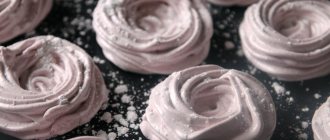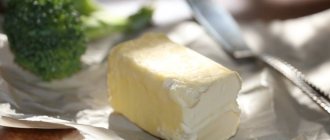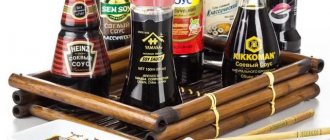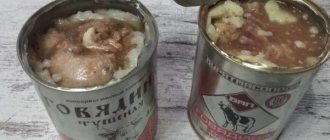STORAGE LIFE OF CONFECTIONERY FLOUR PRODUCTS
The shelf life of each type of product is determined not only taking into account its composition, but also taking into account the type and quality - wrapping, packaging, properties of the wrapping material and storage conditions. For each type of product, optimal storage conditions are established: optimal temperature, optimal relative humidity. Current GOSTs and OSTs determine the shelf life of products under recommended storage conditions.
A wider temperature range is allowed when storing cookies
(18 ± 5) C. If the relative air humidity is not more than 75% during storage and the temperature indicated above, the shelf life of cookies from the date of production is allowed from 3 months to 15 days, depending mainly on the fat content: 3 months - for sugar and hard biscuits; for butter cookies with a fat content of no more than 10% - 45 days; for butter cookies with a fat content of 10...20% - 30 days, with a fat content of over 20%, the shelf life of butter cookies is 15 days.
Storage conditions for gingerbread products
(gingerbreads, gingerbread) should be the same as the cookies. The most common defect when storing gingerbread cookies is their drying out. Raw gingerbreads are more susceptible to this defect and, to a lesser extent, custard gingerbreads. But with high relative humidity, gingerbread cookies can become moist and moldy. Raw and custard-type gingerbreads such as mint ones have a minimum shelf life of no more than 10 days in the summer. In winter, this period increases to 15 days. The shelf life of custard gingerbread is longer: 20 days in summer and 30 days in winter. Custard gingerbreads and gingerbreads containing up to 11% fat should be stored for 20 and 15 days, respectively. Raw unglazed gingerbread cookies (except mint ones) and gingerbread cookies retain their quality for 20 days.
Depending on the recipe, type of filling, quality of packaging under unfavorable storage conditions of waffles
their taste and other organoleptic characteristics deteriorate. When absorbing moisture from the air, the waffles lose dryness and their quality deteriorates significantly. Waffles with fat fillings quickly acquire an unpleasant taste of spoiled fat during storage. In warehouses for storing waffles, it is recommended to maintain lower relative air humidity (65...70%) at a temperature of (18 ± 3) ° C compared to the storage conditions for cookies, gingerbread and a number of other products.
Shelf life of waffles
are mainly determined by the type of filling (fat, praline, fruit) and the type of fat used. Waffles without filling have the longest shelf life - 3 months; Wafers with fat, praline and praline type filling - 2 months from the date of production. Wafers with fruit and fondant fillings have a shelf life of 1 month and 25 days, respectively. If only butter is used when using fatty fillings, the shelf life of waffles is reduced to 15 days.
Particularly stringent requirements are imposed on the conditions and shelf life of cupcakes, sponge rolls, rum baba, and especially cakes and pastries.
Under recommended storage conditions for cupcakes (temperature (18 ± 3)°C and relative air humidity no more than 75%), the shelf life ranges from 2 (cupcakes made with yeast) to 12 days (cupcakes made with yeast, but in polymer packaging) . For cupcakes made with chemical leavening agents, as well as without leavening agents (yeast, chemical leavening agents), the shelf life is 7 days.
Biscuit rolls
have different shelf life depending on the type of filling and fat used. Thus, the shelf life of rolls with cream from the time of production does not exceed 36 hours, and with cottage cheese - 24 hours. At the same time, the date and hour of production are indicated on the parcels of piece rolls and boxes. For individual wrapped rolls with fruit filling, poppy seeds and confectionery fat filling, the shelf life is 7 days; for weight rolls with the same types of fillings and fat, the shelf life is reduced to 5 days.
Rolls with cream and cottage cheese
should be stored in refrigerated cabinets and chambers at a temperature of (4 ± 2) ° C. Rolls with other types of fillings should be stored at a temperature of 6 ... 18 ° C and a relative air humidity of 70 ... 75% without sharp fluctuations. Muffins and rolls that contain preservatives and moisture-retaining additives in the recipe and are hermetically sealed in an inert gas environment have increased shelf life.
Rum baba
should be sold in the retail chain on the day of production, since with high humidity, the presence of sugar and protein substances, they are easily subject to microbiological deterioration: fermentation, souring, mold.
This also applies to cakes and pastries. Products with creams, especially milk (custard) ones, are especially dangerous. A microorganism such as Staphylococcus aureus easily develops in creams. This creates a particular danger for the consumer. These microorganisms do not develop in the cream when sorbic acid (potassium sorbate) is included as salts. In butter creams, the preservative effect of sugar is manifested. The sucrose content in the liquid phase of the cream should not be less than 60%. The effect of sugar is that it increases the osmotic pressure in the environment and thereby prevents the development of microorganisms. Therefore, the sugar content in the liquid phase is the main indicator of the shelf life of products with cream during storage. The sugar content in the aqueous phase is inversely related to the moisture content of the cream. As the moisture content of the cream increases, the sugar content in the aqueous phase decreases.
Cakes and pastries cannot withstand storage and long-distance transportation. Therefore, they are produced everywhere, in bakeries, catering establishments, restaurants and cafes. Products must be sold in places of production (with the exception of shelf-stable cakes, such as “Enchantress”),
Products are often made according to their own recipes and it is important that attention is paid to their safety. To do this, safe raw materials must be used and the optimal moisture content of the products and the sugar content in the liquid phase must be observed. At any enterprise, through calculations and analyses, the moisture content of products and the sugar content in the liquid phase can be determined. Technical specifications strictly regulate the terms and conditions of storage of this group of products.
Cakes and pastries with cream and fruit finishing
must be stored in refrigerated cabinets and chambers at a temperature of
(4±2)
°C.
In the absence of these conditions, the sale of cakes and pastries in the retail chain is not allowed. Cakes and pastries without cream finishing after baking, cakes and pastries with fatty and praline
finishing semi-finished products should be stored at a temperature
not exceeding 18°C
and a relative humidity of 70... 75%.
Chocolate waffle cakes
should be stored at a temperature of
(
18 ± 3) ° C. The shelf life of cakes and pastries under the specified conditions from the time of completion of production ranges from 6 hours to 30 days
or more.
The minimum shelf life is accepted for products with custard and cream (6 days). With curd cream, the shelf life is 1 day. The shelf life of “Potato” cakes and products with butter cream containing a preservative, in the absence of a refrigerator, is 36 hours.
If a refrigerator is available, it increases to 5 days. Chocolate waffle cakes with various finishing semi-finished products have a shelf life and can be stored for 30 days or more. The shelf life of cakes and pastries if they are produced on complex automated lines or on automatic machines increases to 7... 10 days. If the auction includes various finishing semi-finished products, the shelf life is set according to the shelf life of the finishing semi-finished product that has the shortest shelf life.
The shelf life of tenders and cakes can be significantly increased by freezing the products. Cakes and pastries made from various baked semi-finished products (shortbread, biscuit, puff pastry, crumb, almond-nut, puffed), combined with a layer and finishing with all types of creams based on butter and fruit semi-finished products, can be frozen. The exception is products finished with fondant and jelly.
A prerequisite is that cakes and pastries to be frozen comply with current sanitary requirements for the production, storage and sale of cakes and cream cakes. In terms of physical, chemical and organoleptic characteristics, products must comply with the specifications; raw materials and auxiliary materials must comply with the requirements of the standards and specifications. Before deep freezing, a bacteriological analysis of the products is carried out. Products are frozen in refrigeration chambers at a temperature not exceeding minus 20 °C. Cakes must be pre-packed in boxes, and pastries in trays and accompanied by a label indicating the name of the product, date and hour of production. The boxes are placed on trolleys in stacks. Trays of cakes are placed in metal trays with metal lids, placed in up to 15 trays one inside the other or stored in trolleys.
The shelf life of products at a temperature not exceeding minus 18 °C is no more than 3 weeks.
Before sending to the distribution network, cakes and pastries are defrosted in a chamber at a temperature of 0...6°C (defrosting chamber). The duration of defrosting for cakes is 12 hours, for pastries - 4...5 hours. The date and hour of the end of defrosting are considered to be the same hour as the production of cakes and pastries. After defrosting, the shelf life of products at a temperature not higher than 6С and not lower than 0*С is 36 hours. Boxes with cakes must be marked with detailed information for the consumer (trademark or name of the manufacturer, name of the product, net weight, date and hour manufacture, price, OST 10-060 - 95).
The quality of products and their safety also depend on the quality of their transportation to the distribution network. The transportation conditions for each type of product are predetermined by the relevant standards, taking into account the specifics of the product, the type of wrapping or packaging.
The general requirements are as follows. Transportation must be carried out in clean, dry, pest-free grain stocks, covered vehicles or carts, by all types of transport in compliance with sanitary rules. During transportation, loading and unloading, products must be protected from precipitation. The use of vehicles in which poisonous or odorous goods were transported, as well as transportation together with other products with a specific odor, is not allowed.
Transportation, loading and unloading of a number of products (rolls, tenders, cakes) must be carried out with great care, without impacts or sudden shocks.
Compliance with optimal storage and transportation conditions helps preserve those consumer qualities that are formed during the technological process and for which the consumer values the product.
Recommended pages:
Use the site search:
Storing eclairs
To preserve eclairs, you need to understand how to store them correctly so that they do not spoil and lose their taste. Eclairs without filling and with filling are stored differently, homemade and purchased. The type of filling affects the storage method .
The main criteria for storage conditions are that the products do not become rotten, frozen, dry, or damp. Different housewives have different attitudes to these criteria. The least fear of cakes is refreezing . The choux pastry does not freeze in the freezer and remains soft. The worst thing is considered to be if the products become damp. This cannot be allowed. Not very good and overdried.
It is difficult to preserve eclairs filled with whipped cream . The filler settles quickly.
The shelf life of eclairs is determined by whether the eclairs have a filling or not. If the cake is already filled, then it matters:
- Type of filling.
- Presence of preservatives in the filling.
- Conditions in which eclairs are located.
There is another reason that forces eclairs to be stored according to certain rules. It is recommended to fill the shell only before eating the cake . Choux pastry retains its taste properties in almost any storage method. For 5 days, the cake blanks can be stored in the refrigerator either wrapped in cling film or in a closed food container. At the same time, you need to make sure that they do not become damp. The open shell of the cake cannot be preserved; it will dry out and become stale.
do without a refrigerator when storing cakes for more than three days . Ingredients may spoil. Experienced housewives recommend putting them in an enamel or glass container and loosely covering them with a lid. If you don’t close the lid at all, the uncovered eclairs will dry out, and in a tightly closed container they will become damp. Some housewives store it in a tied plastic bag. The filling of homemade cakes should be done immediately before consumption.
If longer storage is required, then eclairs without filling can be placed in the freezer . You need to cut the hot cakes, cool them, carefully place them in a freezer bag, release the air from the bag, close it and safely put it in the freezer. Shelf life up to 90 days . Remove from there as needed, defrost in an oven 180 degrees for 2-3 minutes , and then you can start stuffing. Cannot be re-frozen.
Storing eclairs without filling
Eclairs without filling can be stored without refrigeration for up to 72 hours . It is recommended to place them in an enamel bowl and cover loosely with a lid. Uncovered eclairs will dry out and become damp in a tightly closed container, so try to find a middle ground. In the refrigerator, the shelf life will increase to 5 days , but the eclairs should be placed in an airtight container or wrapped in film so that the cake blanks do not become damp.
Storing filled eclairs
Filled cakes bought in a store are stored in accordance with the recommendations written on the factory packaging. There is printed information about the composition of the filler, release date and requirements for storage conditions.
When purchasing, you need to pay attention to the expiration date of the product . As a rule, the filling of such products contains preservatives, and the shelf life of the delicacy is up to 5 , and sometimes even up to 7 days at a temperature of +4°C-+6°C .
In hot weather, without refrigeration, it is recommended to store cakes for no longer than a few hours . Filled eclairs should always be stored in a cool place . The storage duration depends on the type of filling chosen.
At elevated temperatures, they need to be eaten quickly , regardless of their filling.
If the eclairs are homemade, then the shelf life will be shorter, because... Housewives usually do not use preservatives at home. The shelf life will depend on the type of filling chosen. Eclairs with filling must be stored in the refrigerator.
When storing filled eclairs, it is useful to focus on the following information on the expiration dates of various fillings:
| Type of filling | Shelf life (hours) at T +4°C - +6°C |
| Natural whipped cream | 6 |
| Oil cream | 120 |
| Custard cream with butter | 12 |
| Custard without oil | 72 |
| Protein cream | 72 |
| Yoghurt cream | 36 |
| Curd cheese cream | 36 |
| Boiled condensed milk cream | 120 |
— wheat flour according to GOST R 52189;
— granulated sugar according to GOST 21;
— potato starch according to GOST R 53876;
— condensed milk according to GOST R 54540;
— “Agar-agar” according to regulatory and technical documentation;
— natural coffee according to GOST R 51881;
— drinking water according to SanPiN 2.1.4.1074;
— vanilla in pods according to regulatory and technical documentation;
— canned fruits according to the manufacturer’s specifications or other regulatory and technical documentation;
— confectionery gel according to the manufacturer’s specifications or other regulatory and technical documentation;
— non-melting powdered sugar according to the manufacturer’s specifications or other regulatory and technical documentation;
— glaze according to GOST R 53897;
- cottage cheese according to GOST R 52096;
— almond kernel GOST 16831, GOST 32857;
— cream cheese according to the manufacturer’s specifications or other regulatory and technical documentation;
— vanillin according to GOST 16599;
Features of choice
The first thing we pay attention to when purchasing a cake or pastry is its taste. A confectionery product should attract us and make us want to eat it as soon as possible. But there are points indicating the shelf life of the cake that many do not notice.
- The first is the place where confectionery products are stored. They must be located in display cases specially designed for these purposes.
- All equipment must be clean, neatly decorated, and with a wide viewing angle. It’s great if the display case is glazed on all sides, then you can see the purchased confectionery product in all its details.
- An important aspect here is the expiration date, which each manufacturer indicates on the box with the cake.
- Unnaturally bright colors of cream and decorations indicate a large number of artificial dyes and other harmful additives.
- It is best to ask to hold the box in your hands and read the ingredients. A high-quality confectionery product that will benefit health uses only natural products - cottage cheese, sour cream, cream, eggs.











